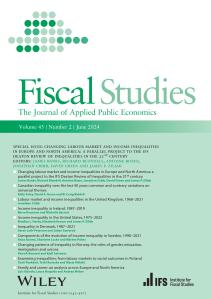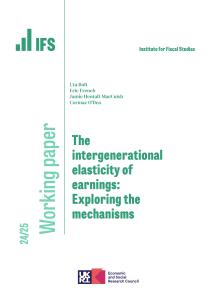Over the last 20 years, growth in the earnings of working fathers has been extremely slow, at 0.3% a year on average, while mothers’ earnings have grown by more than 2% a year. As a result, it has become increasingly difficult for families where only the father is working to keep up with other families. This matters: around a quarter of children live in a one-earner couple family – around the same proportion as 20 years ago.
These are some of the findings from new IFS analysis released today, funded by the Joseph Rowntree Foundation (JRF).
Looking in more detail at the incomes of families dependent on fathers' earnings:
- Because 85% of one-earner families do not have a working mother, they have not benefited from the large increase in women’s earnings since the mid 1990s. As a result, while the incomes of two-earner families are 10% higher than in 2002–03, the incomes of one-earner families have not changed over that period. The only reason their incomes are any higher now than in the mid 1990s is that benefit and tax credit payments to this group have doubled since then.
- The average earnings of a working father in a one-earner couple are 6% lower in real terms than in 1994–95. This is even worse than earnings growth for other working fathers, for whom earnings are 10% higher than in 1994–95. This partly reflects the fact that fathers in one-earner couples are now less likely than other fathers to be in well-paid professional or managerial jobs (even though their relative education levels are unchanged). It also partly reflects the fact that these fathers are increasingly likely to have been born abroad (35% of them in 2015–16): those born abroad tend to earn less than those born in the UK with the same qualifications. But even among those born in the UK, average earnings for fathers in single-earner couples are lower than 20 years ago.
These trends are important for understanding low living standards among children:
- 43% of children living with one working parent and one non-working parent were in relative income poverty in 2015–16, after accounting for housing costs – up from 33% in 1994–95. This compared with a relative poverty rate of 11% for children of two working parents in 2015–16 and 33% for children of working lone parents.
- One in three children in relative income poverty have one working parent and one non-working parent – up from one in four in 1994–95. Roughly as many poor children are in this kind of family as are in a family with no one in work.
- Parents in one-earner couples are much more likely to say they cannot afford important material goods for their children (such as a warm winter coat) than parents in two-earner couples. This is despite much higher childcare costs for two-earner couples. However, ‘material deprivation’ on this measure is still higher for the children of working lone parents.
Certain types of families are particularly likely to be one-earner couples:
- 30% of one-earner couples with children have at least one non-white member, compared with 14% of families with two working parents. This is because the employment rate of white mothers, at 72%, is higher than that of Asian mothers (49%) or mothers of other ethnicities (59%). This helps to explain higher rates of child poverty among non-white families.
- Couples with younger children, and with more children, are more likely to have only one parent in work – as one would expect given childcare responsibilities and potential costs. Nevertheless, almost half of one-earner couples with children have no children aged under 5.
Jonathan Cribb, a Senior Research Economist at IFS and an author of the new report, said:
"With men's earnings growing so slowly over the last 20 years, it has become increasingly hard for families dependent on the father’s earnings alone to keep up with other families. The average incomes of one-earner couples with children have not grown at all since the early 2000s, and the only reason that they are any higher than in the mid 1990s is the greater generosity of benefits and tax credits."
Andrew Hood, a Senior Research Economist at IFS and another author of the report, said:
"Boosting the incomes of large numbers of families dependent on fathers' earnings may well be challenging. The vast majority of the fathers are already working full time, most of the mothers are not actively seeking paid work, and increases in in-work benefits targeted at the group would be likely to further weaken the financial incentive for those families to become dual earners. But increasingly it is a challenge that governments wanting to improve the living standards of low-income children should be considering."
ENDS
Notes to Editors
1. "In-work poverty among families with children" by Jonathan Cribb, Andrew Hood, Robert Joyce and Agnes Norris Keiller will be published on the IFS website www.ifs.org.uk at 00.01 Monday 10 July 2017.
For embargoed copies, or if you have any questions, please contact Emma Hyman in the IFS press office: @email / 020 7291 4850 / 07730667 013.
2. This paper forms a small part of the wider and flagship annual publication 'Living Standards, Poverty and Inequality in the UK'. This publication will be launched in full on Wednesday 19 July 2017 and a separate press release for outlining our overall findings will be issued closer the time. You are welcome to sign up to attend the launch event: https://www.ifs.org.uk/events/1484
3. This work has been produced with funding from the Joseph Rowntree Foundation (JRF). The Joseph Rowntree Foundation is an independent organisation working to inspire social change through research, policy and practice. For more information visit www.jrf.org.uk JRF is on Twitter. Keep up to date with news and comments @jrf_uk. For press releases, blogs and responses follow @jrfmedia.










